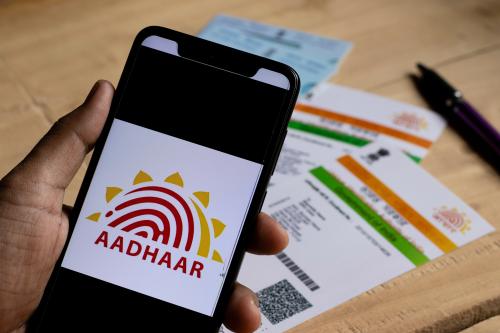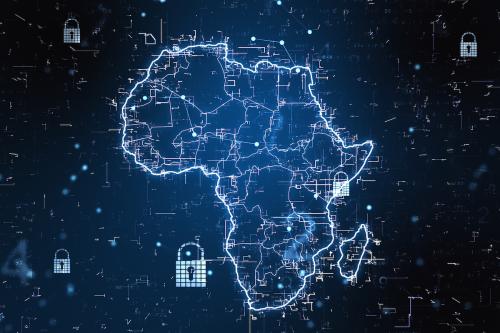Digital technology was a reoccurring theme last week at the Biden administration’s Summit for Democracy on “defending against authoritarianism, addressing and fighting corruption, promoting respect for human rights.” COVID-19 has highlighted how central digital capabilities are for all aspects of life—work, health, education, commerce, and government. Digital infrastructure and government services are no longer just nice to have, but essential elements of a 21st century nation. Digital capabilities are ideologically neutral and can serve authoritarian as well as democratic tendencies, so development donors must be wary of whom they partner with and how they deliver assistance for digital government.
Components of digital government
In a new working paper, we identify the key elements of digital government, present data on how developing countries are adopting digital government, and provide recommendations for donor support.
There is no definitive definition of digital government, sometimes referred to as e-government, nor agreement on its principal components. The paper, based on an assessment of what is required for a government to effectively function digitally, identifies six key components of digital government:
- Digital infrastructure. A comprehensive network of digital infrastructure is required to run digital government platforms and for individuals, business, and civil society to access and utilize those resources.
- Digital literacy. Government staff and digital users must be literate, not just digitally, but in the basic skills of traditional school learning.
- Digital data/communications/services. Digital government data and services need to be constructed on a common platform, not department-by-department or service-by-service, that is based on whole-of-government standards and interoperable.
- Digital participation. Digital government must facilitate and encourage citizen use by being easy to access and responsive to user input and needs.
- Digital institutions/policies/regulations. Existing institutions and policies must be modified to function alongside digital applications and adapted for digital use, depending on whether the specific application lends itself to being fully digital or requires companion analog operations.
- Digital security and rights. The systems must be secure from cyberattack and protect data privacy and rights.
The digital divide among countries
Digital development largely tracks with national income (Figure 1). Eighty-seven percent of the population in developed countries is reached by 4G coverage, compared with 65 percent in developing countries and 25 percent in least-developed countries. The urban-rural divide is 87 percent-81 percent in developed countries, 65 percent-28 percent in developing countries, and 25 percent-10 percent in least-developed countries. The gender gap in internet usage is modest in developed countries, at 88 percent-86 percent; the gap widens to 49 percent-40 percent in developing countries and to 28 percent-15 percent in least-developed countries.

Consistent with the level of economic development, the sub-Saharan Africa region scores the lowest on indexes of overall digital government readiness and lags on all six components. South Asia follows next and is particularly in need of support in digital literacy and digital infrastructure. There is a wider range of digital readiness across the six components for East Asia & Pacific, Middle East & North Africa, and Latin America & Caribbean. The developing countries of Europe & Central Asia score better than other regions, but still lag considerably behind wealthy countries. Overall, developing countries score best on digital literacy and worst on government effectiveness.
How donors can engage
Low-income countries (LICs) and lower-middle-income countries (LMICs) are in dire need of assistance in all aspects of digital government. Support is required not only on the strictly digital components of ICT (information and communication technology) infrastructure, digital data and services platforms, digital participation, and digital security, but also on upgrading and adapting to the digital world the analog components of government institutions and regulations, in addition to digital literacy and human capital development.
Donors are currently supporting various digital development initiatives, but too often in one-off, siloed applications rather than as part of a comprehensive, strategic plan. Donors should build their support around national digital strategies and find ways to overcome barriers to donor coordination. The scale and urgency of need are such that donors should collaborate through establishing a comprehensive global digital initiative and regional efforts like the African Union’s digital transformation strategy for Africa. As appropriate, they should draw from and contribute to global public goods, as cataloged by the Digital Impact Alliance in its Catalogue of Digital Solutions, and utilize existing capabilities and platforms as provided by Future State, MOSIP, and GovStack.
Expectations for donor support must be realistic. An initiative can undertake only so much. A digital government initiative, even a comprehensive one, is likely to focus mainly on digitally specific components—telecommunications infrastructure, government digital capacity and online services, digital participation, and cybersecurity. For the other components that support digital government, there are existing well-established donor programs in building human capacity through education and training, in strengthening government institutions, services, policies, and regulations, and in advancing democracy and political participation. Ideally, a digital lens would be embedded in these traditional programs to create mutually strengthening synergies with digital government: education programs addressing digital literacy, institution building efforts adapted to the digital world, and democracy programs focused on citizen engagement in an online world.
The benefits and challenges ahead
If there is any question about the value and urgency of moving to digital government, one need only look at how a few digitally ready developing countries responded rapidly to COVID-19. Sri Lanka was able in two days to configure an existing digital health platform to track incoming travelers from high risk areas. India was able within a few weeks to use its Aadhaar digital ID system to begin transferring $8 per month to 200 million vulnerable women. Within 10 days, Togo built on an existing digital platform a system to enroll and transfer monthly cash payments via mobile phone.
The benefits of digital government are clear. Done properly, it allows government to be more efficient, more responsive to citizen input and needs, more transparent and accountable, and to act and adapt more quickly. With the right data and “last mile” connection efforts, it allows government services to be better targeted and to reach remote and underserved communities.
But along with the benefits come dangers. The misuse of digital capabilities extends from demagoguery to repression and abuse of human rights. Digital technology can be deployed by authoritarian regimes to maliciously strengthen their power over citizens. The same digital capabilities that allow government to be more engaged with and responsive to citizens also allow it to be more controlling. It provides government the tools to infringe on citizen privacy and track their communications and movements. It can be used for misinformation and disinformation and to misrepresent and block communications of opposition forces.
Principles of good digital government
As donors work to advance the digital capabilities of developing country governments, they must be constantly alert as to how those capabilities can be misused. They must carefully choose the partners with whom they work. The support they provide must be accompanied by the ethos of full transparency and, first and foremost, be citizen-centric.
At the Summit for Democracy, USAID Administrator Samantha Power called for a Surveillance Principles Initiative, consistent with the Universal Declaration of Human Rights and the rule of law, that protects user data and fights discrimination. Beyond that, donors, to ensure their support for digital development is deployed for benevolent and constructive purposes, should develop a set of principles designed to wall off the capabilities of digital government from misuse and abuse and protect open government and the rights and privacy of citizens.
This is not something for government to do alone. The private sector possesses the technology, does much of the investment, and is constantly innovating, so must be a party to any set of principles. Civil society is best at protecting the rights of individuals and holding government and the private sector accountable. Partner countries have to be in accord with what is put forward. So, if it is to be effective, this set of principles must be a multi-stakeholder charter jointly built and with mutual accountability.








Commentary
How can digital government advance global development and democracy?
December 15, 2021